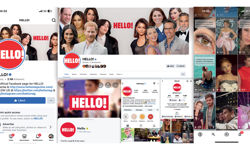Launching a free, weekly, advertising-reliant print product during a recession into an already heavily saturated women's magazine market was always going to be a bit of a gamble. Three years on, however, and it certainly seems to have paid off with Stylist and its editor, Lisa Smosarski, voted Consumer Media Brand and Editor of the Year, Consumer Media, respectively at the PPA Awards earlier this year. Not bad going for a title some in the industry snobbishly dismissed at launch for being free.
Culture shock
Looking back, Smosarski, who in September also made it into the Guardian's prestigious Media Guardian 100, does admit the transition from Bauer - where she was editor of More! - to ShortList Media was "a bit of a culture shock". But that had nothing to with the freemium business model.
"It was a shock when I first got here," she smiles. "The team was so tiny. The CEO sat just inches away. But what was great was how much face time I had with the powers that be and how quickly decisions were made. Lack of IT and general office facilities, like a cleaner, were quickly outweighed by a wonderfully creative, enthusiastic working culture. I won't knock the experiences I had at other companies, but Stylist was - and still is - different, and it was nice to get out of the old, familiar comfort zone."
Smosarski also had concerns about the size of the team and the magazine's likely reception: "There were 12 of us at first. This was a challenge as we wanted to produce monthly-style journalism weekly - which is a tall order when resources are tight. Now, thankfully, the team is almost twice the size."
A bigger worry, however, was whether the title could ever command the respect of the leading agents who act as gatekeepers to the biggest Hollywood names. "Celebrity access was a big fear of mine before we launched," she admits. "But thanks to the early support we had from a number of key UK film companies who helped smooth the way, it was never a problem."
Despite such reservations, Smosarski says she was interested in the job as soon as she first heard that ShortList founder Mike Soutar was considering a women's weekly using the same freemium model. "I'd loved ShortList as a reader and from a magazine publishing perspective - the features are so diverse, the covers are creative and clever, then there's the service element - and as soon as I heard about it, I wanted to get involved," she reveals.
"I knew what the potential for a women's product could be. Creatively, a new untested advertiser-funded product launched by a small company was exciting. And it came at a point in my life when I thought I could afford to take the risk."
The freedom of freemium
Freemium, she soon found out - and still firmly believes - is "an editor's dream" because of the flexibility that exists in not being tethered to the newsstand. "It's all about the creative flexibility it offers," she explains. "On the newsstand, you end up in a bun fight and, as a result, your response is templated. You have a set roster of celebrities that you know will work on the cover, and a set roster of cover lines. Not having to fall back on that template is where the creative freedom comes in."
An early criticism of free titles, especially those pre-Metro, was that if anyone could pick up the product, then its content would be somehow devalued, Smosarski adds: "But as we've proven, though you are free, you can still have creative covers, intelligent and thoughtful, playful content and delight the reader."
There are, it seems, a number of key ingredients for getting the freemium formula right.
"Newsstand may not be an issue for a free title, but you still need a strong cover to set out your stall, to quickly sum up the issue and flatter the reader - to provide a badge," she explains. Powerful covers are also essential to clearly distinguish between one issue and the next and Stylist has had many over the past three years, including a PPA award-shortlisted edition sporting a memorable image of Nigella Lawson with salted caramel melting down her face.
Feminist agenda
Editorial agenda is another key differentiator - and one that emerged out of extensive pre-launch research into what the title's target audience of 20 to 40-something intelligent, professional women would want in a new magazine. "Ours is a very broad definition of 'women's interest' - very feminist in its slant, very interested in empowerment, factual and science-based subjects and quirky stories as well as culture and the arts," Smosarski says.
"We set out to show women are multi-faceted and intelligent by actively avoiding topics that have become women's magazine staples - such as your man, your weight, embarrassing pictures that demean celebrities. We deliberately went against the market to reach out both to women who love magazines by offering them something different, and the many women out there who had decided magazines just weren't for them."
This also explains the magazine's evolving interest in campaigning themes - it is currently running 'Fair Game' to lobby for women athletes to be rewarded as well as male athletes - and a growing commitment to irregular themed specials. In August, for example, it produced an issue from the Saatchi Gallery where the team de-camped for a week to work out of a pop-up office.
Popular franchises within each edition of the magazine are the shopping section: The Style List - a stylish, graphic, eclectic opening spread; Work/Life - a day in the life of slot (for women subjects, naturally); news section Scoop; Escape Routes (travel); and Out Going - ie. going out. The ‘service element’ is key, she says: "Because there’s a big need for edited choice among our time poor readers hungry for new experiences."
The same thinking also drives the measured digital development of Stylist since the magazine's launch. After a year, during which the magazine existed as a standalone, print-only product, the company started daily e-newsletter Emerald Street (named after the road in Clerkenwell where ShortList Media is based) - it currently has 100,000+ subscribers - and also a Stylist website where visitors can access both current and past issues and original content.
"Emerald Street is a very ShortList Media way of looking at digital. The idea is to send content direct to each reader, daily - selecting the most successful elements of the magazine then adding to this extra original content so it's not just a re-hash," Smosarski says. "Ours is a particular way of approaching digital content as we don't need paywalls because our content is free, so it's about sharing content across all platforms and producing additional digital content to supplement this."
She quickly underlines this with the declaration that the company will never put a cover price on Stylist - nor would it ever make Stylist a digital-only proposition.
"Free, quality content distributed across a variety of platforms is core to the freemium proposition," she adds, "and central to the philosophy of the company." Growth, too, while desirable is not seen as an end in itself. Since launch in October 2009, weekly circulation was grown steadily to 431,266 (January-June 2012) and Smosarski says she is confident as distribution grows from the 11 cities where Stylist is currently distributed, another 100,000 on top of this could be "pretty easy" to achieve.
Editorial integrity
"But the priority is quality of content," she continues. "That's what's key to protect what we've already got, to make sure we don't get complacent or lazy. And that's where social media has such an important role to play. From day one of launch, I've published my email in the magazine and received hundreds of messages a week from readers about each issues and individual features. Facebook and Twitter provide a quick and easy measure of people's response to what we are doing. It's incredibly important never to forget that success could go as fast as it has come."
Given Stylist's dependence on advertising revenue, how different is its relationship with brands from the relationship cultivated by paid-for mags?
The answer, she says, is exactly the same: "Paid for editorial is easy to criticise but, hand on heart, we have no pressure exerted on us in this way. The relationship Stylist has with its advertisers is no different to the relationship I've had with advertisers editing any other magazine: you nurture the relationship, but not to the extent the advertiser ends up driving content. True editorial integrity is key and always has been."
In fact, she adds, because of the low expectations some had of the freemium model at Stylist's launch, if anything, the title has had to work even harder to prove its integrity and commitment to quality. It's all about proving and continuing to prove to the world that free can equal quality.
"One of the most important lessons I've learned since being here is: don't scrimp on quality - quality of anything, of print to journalism - because you'll be criticised faster by the industry, by the advertisers and by the readers than if we weren't free," she believes. The reason? The legacy of a view that not so long ago held sway about free titles being "a bit of crap supported by classifieds".
It's annoying, but a fact of life. And so too is Smosarski's belief that, three years in, there's still much, much more she can do in terms of fresh, creative ideas, covers, features and campaigns for the magazine. "I'm still as excited doing this job now as I was the day I took it up," she declares. "I'm incredibly lucky - because we're growing all the time, and because we have a licence to push the editorial every week. It's what people now expect of us, and it's what makes Stylist work."












